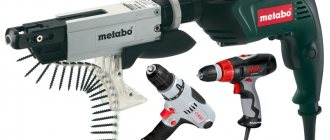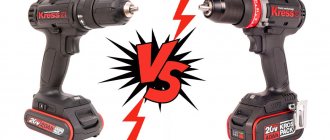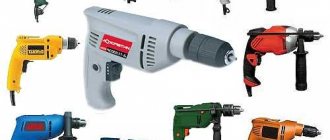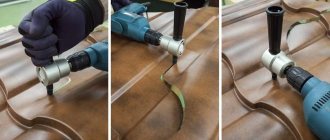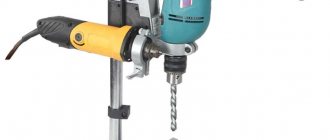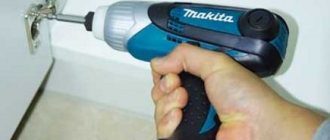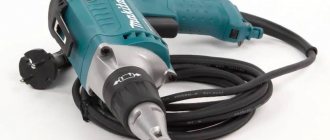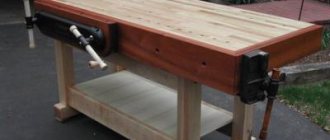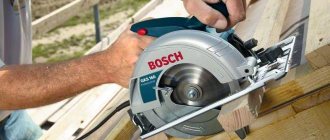The screwdriver has successfully replaced not only various types of screwdrivers, but also wrenches and hex keys. This tool is also used instead of a drill. For builders and furniture makers, an electric screwdriver has become an indispensable assistant. There are always uses for it at home. The range on the market is represented by a wide variety of models. Despite the prevalence of screwdrivers in various fields of activity, not all users, especially beginners, know how to operate them. Proper use, maintenance and storage of power tools will maximize their service life.
Is it possible to drill concrete with a screwdriver?
To answer this question, you need to know in what material you need to drill holes, what depth and diameter. Holes with a diameter of 10 mm or more are problematic to make using a screwdriver. But if the drill is thin (3-5 mm), then you can drill with such elements using a screwdriver. The rotation speed of the drill affects the ability to drill into hard materials. For screwing, a value of 500 rpm is suitable, and concrete can be drilled with a tool with a head rotation speed of 1300-1500 rpm. Equally important is torque, namely, how much force is applied to tighten the screws or drilling process. For concrete, choose a screwdriver with a power of 140 N/m, using it in the working extreme position of the coupling at maximum power.
Work principles
You should always keep in mind that you are going to use the tool for purposes other than its intended purpose, and this comes with some difficulties and limitations.
Basic rules for safe and efficient use of a drill as a screwdriver:
- Follow safety requirements. Handle the tool with care.
- Do not tighten the screws all the way - this can lead to breakage of the tool, bit, or object being screwed. Experienced craftsmen advise to under-tighten the screws a little, and then finish them manually using a screwdriver.
- To securely attach the bit, it is recommended to use extended bits or a specialized bit holder.
- For wooden material, to avoid splitting the wood, it is recommended to first drill holes and only then tighten the screws.
Of course, it is better to use a screwdriver for such purposes, but a drill
will also cope with these types of work.
Design features and characteristics
The design of the screwdriver consists of the following elements:
There are 2 main types of power source for power tools:
The battery type loses performance when discharged, so before use you should charge the tool each time according to the instructions. Corded screwdrivers do not have this problem, since they are connected to the network by cable. For drilling concrete, the device is equipped with an impact drilling function with a switch for the direction of rotation of the head - obverse and reverse. The second mode is used for dismantling. To drill holes in concrete, the models provide a torque adjustment function. This is necessary so that the slot and replacement bits do not become unusable.
Manufacturers of hand tools: TOP 4 popular devices
DeWalt DCD985M2
Device type - drill-driver with impact mode, designed in the form of a pistol, equipped with a quick-release chuck, backlight and engine brake. Characteristics of the presented model:
Makita BHP 452 RFE
Cordless impact drill/driver with 2-speed gearbox and LED backlight for easy work in poorly lit rooms. Used for drilling and impact drilling. Main characteristics:
BOSCH Uneo
This model combines a hammer drill, an electric drill and a screwdriver in 1 tool. Using a powerful pneumatic impact mechanism, you can easily drill holes in hard materials: concrete, brick. Product characteristics:
Metabo PowerMaxx SB
A mid-price battery-powered impact drill/driver is designed for both home and professional use. The metal planetary gearbox and powerful electric motor provide high resistance to overloads. Main characteristics:
Preparation for drilling
Before drilling, you need to fix the screwdriver in drilling mode. The tool has an arrow pointing to a drill icon. The screwdriver must be held slightly perpendicular to the drilling axis. In order for the drill to go deeper into the material, you must press down on the tool. But not too much, otherwise you might break the drill and hurt your hands. During operation, the pressure should be loosened and the drill should be removed from the hole to remove metal chips and dust. This information will be useful to know how to drill a wall with a screwdriver.
The drill icon may look different depending on the tool model. Impact screwdrivers will have a picture of a drill with a hammer.
What sharpening angle do steel drills have?
When sharpening a twist drill for drilling steel, it is necessary to obtain a point angle of 116-118°. The machine has a holder for fastening drills, located at an angle of 58-60° to the axis of the circle (Fig. 269), which makes it possible to maintain an angle of 116-118° at the tip of the drill.
Interesting materials:
How to fight inflation briefly? How to deal with lilac? How did Hogweed appear in Russia? How do you say Christ is risen in Armenian? How will pensions be indexed for working pensioners after dismissal? How to fall asleep faster at night? How to quickly gain vocabulary? How to quickly peel corn from grains? How to quickly clean sprouted mung beans? How to quickly peel boiled corn from grains?
Drilling
The process of drilling concrete is not particularly complicated and consists only of the ability to work with the tool. When working with drills, you should combine the hammer mode with drilling.
Before drilling reinforcement in concrete, you need to change the tip for working with concrete to a regular metal drill and drill through the obstacle. It is important to remember to turn off the bumper mode before drilling into the concrete.
In addition to the above, there are also a number of useful tips that will help you achieve quality results.
Is it possible to drill into a concrete wall with a screwdriver?
Types of screws for concrete
A concrete screw or dowel is a cylindrical, elongated part with a head on one side, a thread in the center and a sharp end on the other side. The head of the element can have the form of a hexagon or a cross groove in its center.
Is it possible for a nursing mother to visit the bathhouse?
For the manufacture of dowels, high-hardness carbon steel is used, which makes the concrete screw quite strong, and the application of a special protective coating protects the elements from corrosion and improves mechanical properties. The article introduces the types of screws and methods of using them on concrete.
Types of hardware
Concrete screws come in several varieties.
What are self-tapping screws for concrete, their classification and features can be seen in the table:
| Type of screw | Peculiarities |
| According to the shape and pitch of the thread | |
| The diameter of the parts is 3-6 mm, length from 12 to 220 mm. A special feature of this type of hardware is that they can be screwed into a pre-drilled hole. These are multifunctional products. | |
| Universal with herringbone thread | The diameters of the hardware are 3-8 mm, the length is from 12 to 220 mm. These are universal screws for concrete; they can only be used in conjunction with a dowel, which is most often included with a dowel. If there are voids in the concrete wall, it is recommended to use an impact dowel during installation. In this case, the lengths of the screw and dowel are the same. The hole for the hardware is drilled 3-5 mm deeper than the length of the screw itself. |
| Variable thread dowel | For such a dowel on concrete, you need to pre-drill a hole, but they do not need dowels. The presence of serrated threads allows the screw to easily fit into the wall. The diameter of such hardware is 7.5 mm, and the length can vary between 70-200 mm. The optimal dimensions of the product are 7.5x72 mm. |
| According to the head design | |
| These are screws with a Phillips slot on the head plane. | |
| These screws are screwed in using an open-end wrench. | |
| Parts with threaded rod for nut. | |
| This is an anchor with a hook. | |
| These are rarely used concrete screws; the countersunk torx head has an asterisk slot on the head - a hexagon. In addition, a countersink is provided on the inside of the head, which guarantees the tightest possible fit of the fastener to the product, which is attached to the concrete base. | |
| By type of coverage | |
| Finished parts have an oxidized coating. Used in indoor areas with normal humidity. | |
| This dowel is zinc coated. Can be used in any conditions inside and outside the building. | |
| Yellow zinc plated. This type of screw is most often used for aerated concrete or indoors. |
Tip: All these models are mounted only in a pre-drilled and properly prepared hole.
Part parameters
Characteristics of black self-tapping screws for concrete
When choosing screws for concrete, their sizes must be selected according to the applied load.
General view of the dowel for concrete
Pins for concrete are manufactured according to developed state standards - GOST 1146-80. When ordering fasteners, indicate the dimensions of one part and the total weight of all elements.
Fastener selection
Before screwing a screw into a concrete wall, you must correctly select the fastening element itself and the diameter of the drill.
In appearance, the anchor self-tapping screw for concrete is practically no different from simple screws. But there are some special characteristics that products suitable for DIY installation in concrete surfaces must have.
Can I drill into a concrete wall with a screwdriver or electric drill? In fact, you shouldn't ruin your instrument.
Find a hammer drill and don’t worry, but as a last resort, choose the right drill, taking into account the following criteria:
Features of using self-tapping screws
Using such fasteners is quite convenient and simple. The instructions recommend drilling a hole in advance before screwing a screw into a concrete wall.
Before screwing a screw into concrete, you will need:
Tip: It should be borne in mind that there is no clear answer to the question of whether it is possible to drill concrete with a screwdriver. In this case, work should be carried out very carefully and only as a last resort.
Drill attachment for cutting sheet metal: scope of application
The main purpose of such an accessory is the processing of metal blanks, mainly sheet iron. The variety of options and types available on the market makes it possible, with proper practice, to produce not only straight cutting, but also shaped cuts, which is necessary when:
- roof installation;
- installation of air ducts;
- manufacturing a drainage system.
When choosing a specific type, you need to decide on the scope of future work. There are commercially available tools for cutting round holes, which resemble a milling machine in operation.
Also, using the nozzle, you can obtain devices for grinding metal, which is important when it is necessary to process edges or seams, especially after welding or cutting work.
All models of devices on the market are divided into certain types according to their area of application. They are:
- for performing corner drilling;
- performing grinding work;
- for drilling;
- allowing surface polishing;
- used for sharpening;
- used directly for cutting.
The difference in accessories for power tools for cutting metal lies not so much in the functional features, but in the permissible thickness of the sheet being processed, which also needs to be taken into account when choosing the optimal option.
- https://prosto-instrumenty.ru/nasadki-na-drel-dlya-rezki-metalla/
- https://moiinstrumentu.ru/nasadka-dlja-razrezanija-metalla-na-drel-zachem-nuzhna-i-kak-polzovatsja.html
- https://stroyday.ru/stroitelstvo-doma/instrumenty-i-oborudovanie/nasadka-na-drel-dlya-rezki-metalla-kak-vybrat.html
- https://remoo.ru/instrumentyi/nasadki-na-shurupovert
- https://proinstrumentinfo.ru/nasadka-na-drel-dlya-rezki-metalla-sverchok-tsena-nozhnitsy-video/
- https://homius.ru/nasadka-na-drel-dlja-rezki-metalla.html
Tips for drilling concrete
Users are often interested in how to drill concrete with a screwdriver and whether it is possible. Concrete is a fairly strong material, so you need to take into account the diameter of the hole and its depth. If a hole with a diameter of more than 10 mm is provided, then drilling one will be difficult.
When drilling concrete, use drills with a diameter of 3-5 mm . Particular attention should be paid to the speed. If you screw in simple fasteners, 500 rpm will be enough. But for drilling you will need 1300-1500 rpm.
Another criterion for concrete work is torque . For such purposes, select a screwdriver with a rating from 90 to 140 Nm. It turns out that you can drill through a concrete wall with a screwdriver. The tool will also be useful for drilling brick walls.
Some craftsmen use a screwdriver to drill holes while fishing . A lot of torque is needed here. Separate Makita models and Metabo tools can handle this.
A screwdriver can easily drill concrete up to 10 mm
"Cricket"
Efficient, reliable and popular attachment. Shaped like scissors. This cutting mechanism ensures an even cut. It cuts flat or profiled steel, aluminum, composite, copper, and zinc equally effectively. In addition to cutting steel, it can be used for cutting thin polymer materials.
The “cricket” cuts steel up to 1.5 mm, stainless steel up to 1.2 mm, and copper and aluminum sheets up to 2 mm without flaws or defects.
Its design makes it possible to saw in all planes. Make internal cuts without cutting through the workpiece. The comfortable handle provides a reliable and safe grip.
“Cricket” is ideal for processing metal tiles and corrugated sheets. The working part does not destroy the protective layer, preventing corrosion.
A screwdriver that can drill concrete: myth or reality
Origin of screwdrivers
Each tool is created to solve a specific range of problems. Therefore, it is worth starting to consider this issue with a brief excursion into history. It begins with the appearance in Ancient Rome of hand drills, which were driven by rotating the handle. Much later, only in the 19th century, electric drills were created, which increased the drilling speed tens of times due to the higher rotation speed of the electric motor compared to manual rotation of the rotor or crank. Further evolution developed by “crossing” electric drills with other types of tools. We “cross” a drill with a jackhammer by including an impact mechanism in its design - we get a hammer drill. We change the gear ratio in order to reduce the speed and not tear off the heads or spoil the slots of screws and self-tapping screws - we get a screwdriver.
apartments for rent in Blagoveshchensk, Amur region
Why is a screwdriver bad at drilling concrete?
An ordinary electric screwdriver, although it is a type of drill, is structurally “tailored” for other tasks. The key difference is the reduced chuck rotation speed. The operating speed of simple single-speed screwdrivers, which are used in construction and manufacturing, usually does not exceed 750 rpm (compare this figure with the characteristics of electric drills, which have a chuck rotation speed of at least 2500 rpm). This speed is only sufficient for drilling brick (ceramic brick is usually drilled in modes from 400 - 600 rpm), but not enough for drilling concrete (the optimal rotation speed of inexpensive drills for concrete with a diameter of 10 - 13 mm lies in the range from 900 rpm to 1100 rpm).
But more importantly, a conventional single-speed screwdriver does not have an impact mechanism. Therefore, it cannot effectively crumble concrete or brick at the point of contact of the drill with the material. In addition, the design of the gearbox, bearing assembly and limit coupling does not imply significant axial loads. Therefore, using a conventional screwdriver, it is possible to drill concrete only theoretically, but in practice, attempts to drill dense structural materials usually end in lengthy and fruitless picking, as well as accelerated wear of the tool.
Popular drills and screwdrivers with impact mode Grand DA-21UBL Pro from 2,138 UAH. Makita 8391DWAE from 900 UAH. Makita 8271DWAE from 1,080 UAH. Makita HP0300 from 1,725 UAH. Grand DA-21U from 1,389 UAH. Makita HP457DWE from 3,520 UAH. Tekhmann TCD-60/i20 Kit from 2,295 UAH. Xiaomi Shunzao 12V from 1,149 UAH. Vitals Professional AU 1860Pbt… from 2,391 UAH. Grand DA-12U from 1,034 UAH. DeWALT DCD996P2 from 13,999 UAH. Bosch GSB 18V-60 C Professiona… from 6,555 UAH. Ryobi CID1802M from 600 UAH. Bosch GSB 12V-30 Professional ... from 5,099 UAH. Kraissmann 2500 E-ABS 12/2 Li from 1,110 UAH. Worcraft CD-20LiP from 1,995 UAH. Einhell Expert Plus TE-CD 18/5… from 1,799 UAH. Stanley STDC18LHBK from 3,607 UAH. Pro-Craft PA214 from 2,640 UAH. Metabo SB 18 L 602317500 from 5,099 UAH.
Drills/drivers and concrete drilling
Fortunately, the “evolution tree” of hand-held power tools has a “side branch” in the form of drills and screwdrivers, which are represented by a large assortment of corded and cordless models. They are the ones who can (with some reservations and stretches) drill concrete.
To confidently and quickly drill concrete using a drill-driver, you need:
The difference between the impact mechanisms of a screwdriver and a hammer drill
It’s worth dwelling separately on the shock mode. The design of the impact mechanism of a drill-driver is fundamentally different from the design of a similar hammer drill unit. There is no crank mechanism or “drunk” bearing inside the screwdriver, which would allow developing the high impact energy necessary for chiseling concrete. This function is implemented differently: the axial movement of the cartridge is created using two wavy washers (ratchets). When the engine rotates, the cartridge washer “jumps” along the protrusions of the stationary washer. A drill moves behind it, making reciprocating movements and crumbling the concrete a little at a time.
The amplitude of movement of the drill tip is a fraction of a millimeter, and the impact force depends entirely on the force with which the operator presses on the tool. Therefore, the characteristics of drill-drivers do not indicate the maximum impact energy, and they are outright inferior to full-fledged hammer drills in terms of concrete drilling efficiency.
Elprom EPE-810 from 911 UAH. Avangard P-24/900G from 952 UAH. Vityas PE-1400 from 969 UAH. Avangard P-26/950G from 984 UAH. Uralmash PE 1100 from 1,020 UAH. Elprom EPE-1010 from 1,027 UAH. Grand PE-1250 from 1,032 UAH. Interskol P-20/550ER from 1,035 UAH. Belarusmash BPE-1900 from 1,040 UAH. Elprom EPE-920 from 1,050 UAH. TITAN BP75-24 from 1,052 UAH. Eltos PE-1050 from 1,078 UAH. Vorskla PMZ 920-30 from 1,063 UAH. Svityaz SP 24-7 R from 1,067 UAH. Hyundai H 550 from 1,068 UAH. Intertool DT-0180 from 1,097 UAH. Expert BHD 2008 from 1,099 UAH. Vityas PE-1400 DFR from 1,105 UAH. Forte RH 22-6 R from 1,108 UAH. Vityas PE-1500 from 1,110 UAH.
Limited tool capabilities
The possibilities of a screwdriver are far from limitless. Due to its technical characteristics, “tailored” for much simpler tasks, it will drill concrete five to ten times slower than drills and hammer drills that are more appropriate for this work. The diameter and depth of the holes that can be drilled with a screwdriver also leave much to be desired (the maximum size of the drill that can be clamped in the chuck allows you to drill holes for plastic dowels, but not for powerful anchors).
Therefore, a screwdriver is only suitable for occasionally making a hole in the wall. But it is simply not structurally designed for serial drilling of concrete. In order not to accidentally “kill” the tool when drilling a couple of holes for shelves or cornices, you need to have a little patience and beware of excessive loads on the engine and gearbox. Also, while working, you should monitor the temperature of the drill (if it gets too hot, the carbide tips may fall off) and allow it to cool in a timely manner.
Concrete is different from concrete
The concept of “concrete” covers a large number of materials. This includes lightweight cellular concrete (such as foam and aerated concrete blocks, which are used for laying external walls and internal partitions), and dense heavy concrete (used for pouring load-bearing frames of monolithic buildings and structures). There is a huge difference between them in density and strength. For example, the characteristics of typical aerated concrete blocks, from which the walls in your apartment or private house can be made, usually correspond to a strength class from B2.0 to B2.5. The strength of such a material does not exceed 25 - 35 kgf/cm2, which is significantly less than that of the cheapest M50 concrete. The strength of concrete grade M200, which is used for the construction of low-rise buildings, is much greater - up to 200 kgf/cm2. And in high-rise construction, concrete with a high cement content is used, the strength of which reaches 300 - 400 kgf/cm2. Therefore, even relatively inexpensive corded and cordless drills and screwdrivers with a power of up to 750 W can cope with drilling aerated concrete. But drilling dense reinforced concrete with granite filler is beyond the capabilities of even the most “advanced” models; this will require a powerful hammer drill with high impact energy.
Barboskins at the dacha cartoon 2022 actors
conclusions
There are screwdrivers that can drill into some types of graded concrete and concrete blocks. If you do not demand too much from them, then from time to time, using a drill-driver equipped with an impact mechanism, you can drill a couple of holes in a concrete wall. But this opportunity should be considered as a pleasant “bonus” to the main functions of this type of tool: tightening fasteners and drilling wood, plastic and metal.
And if we take into account the cost of the tool, then it is more profitable for an ordinary user to take a simple drill-driver with a two-speed gearbox and, in addition to it, a budget hammer drill than to buy an expensive professional screwdriver “for all occasions.”
Drilling wood with a screwdriver
In this mode, the ratchet stops working ( protecting the motor from overloads ). Therefore, you should drill with caution, otherwise the drill will jam and the engine may become unusable. If you work with a cordless screwdriver, it is a pity to have a lithium-ion ( Li-ion ) battery. It is unpretentious and durable.
Then you can click on “Start” and start drilling. During operation, you need to make sure that the drill does not become distorted. Otherwise it may break off. Most screwdrivers have 2 speeds . If the wood is hard, it is better to choose the second speed. What mode is needed to screw in a self-tapping screw or screw can be judged by the thickness and length of the fastener.
The screwdriver can be used as a drill for drilling wood
Self-tapping screw technology
There are general rules for using self-tapping screws for all materials.
- First, the fastener installation points are marked.
- If it is necessary to use a solid material, the installation location is marked with a thin drill or simply by hitting a hammer with a self-tapping screw, pointed to a point.
- Until the thread of the self-tapping screw begins to cut grooves and it takes a stable position, screwing is carried out at minimum speed.
- Then the speed and pressure are increased.
- As the head approaches the surface of the material, the speed is again reduced and the hardware is tightened carefully so as not to overtighten or break it.
Is it possible to drill through metal with a screwdriver?
If you don’t have a drill press or drill, you can drill metal products with a screwdriver. The main thing is to choose the right equipment. Hardware for concrete, wood or ceramic tiles is shaped and sharpened differently. For metal, equipment is designated by the letters HSS .
To increase strength and wear resistance, the working surface of the equipment is coated with titanium nitride . For hard structure steels, equipment marked R18 . If cobalt is added to the coating composition, the strength of the equipment increases significantly. Now you don’t have to think about how to drill out the lock cylinder of the front door with a screwdriver.
You can even drill alloy steel if the drill tip is carbide. But this is already in the realm of experimentation, since it will not be cheap. If the metal is thin-sheet, cone-shaped drills are used for drilling.
The equipment of the screwdriver for metal is designated HSS
Bracket for receiving drilling machine
The multifunctional bracket will help you convert a standard hand drill (corded, with battery) into a stationary drilling machine. The body is made of heavy-duty aluminum alloy. Massive, allows you to securely install the drill for subsequent drilling. The fasteners are designed in such a way that they are suitable for all modern power tools.
The sole is equipped with a vice, which allows you to fix the workpieces in the desired position and avoid their displacement while drilling holes. The adjustable bracket allows you to set the desired height, taking into account the size of the tool itself. For convenient operation, there is a handle with a rubber pad that smoothly lowers the drill.
Multifunctional bracket for drill and screwdriver
| Price | 2,077.21 - 2,345.32 rub. |
| Rating | 4,6 |
| Reviews | 115 |
| Orders | 188 |
| Delivery to Russia | Free |
Tools
To drill a reinforced concrete surface, you need to use specialized tools - in our version, you won’t be able to get by with a homemade tool.
Based on your preference for the diameter of the hole, you can use a hammer drill, also called a small-sized electric hammer drill. What is the best way to drill a concrete wall in an apartment or panel house: a regular screwdriver with a drill, is it possible to make a hole in a concrete wall with a dust-free hammer drill, and how. Is it possible to drill with a screwdriver? “Is it possible. The first option has less power, but has less weight and an inconvenient design. The hammer drill, accordingly, has greater potential, weight and dimensions.
Read also: Float switch for pumping station
Be careful! Since the use of construction equipment is often one-time in nature, it is more rational to rent them. Considering that their price is quite high, this way you will save a considerable amount of money.
In addition to the existing tools, it is necessary to purchase special drill bits that allow you to work with a concrete surface. For a hammer drill, drills with a Pobedit tip are selected.
A hammer drill has its own weight characteristics and a set of impact attachments, which, in most cases, are quite enough . Drills with a tip are also used as additional components for the hammer drill.
To form holes with a diameter of thirty-five to one hundred and twenty mm, crown bits are used, which have pobedite teeth - using them, grooves for sockets, switches, etc. are drilled. If you are deciding on the question of how to drill concrete with a screwdriver, then there are also tungsten carbide-coated crowns for this. However, please note that they are only suitable for units with a power of two or more than 1kW.
Can it be used as a drill?
As mentioned above, a screwdriver is mainly used for such things, to unscrew or tighten something. When using a screwdriver as a drill, carefully read the instructions to see if this option is provided in the manufacturer’s instructions.
READ How to drill concrete with a hammer drill
If it is still possible to use a screwdriver as a drill in order to drill and make a hole, for example, in a wooden or plastic product, then it is recommended to place a small and even piece of wood under this or that object. This way your hole will be made better and will prevent cracks and chips from appearing.
If your work uses metal, then you need to follow some simple rules. Before you start drilling, the hole location must be tilted to prevent the drill from sliding on the metal. Select drilling mode and get to work. But here we must not forget that when drilling through metal, the drill may break. To prevent this, it is not recommended to press the tool too hard. If it happens that the drill gets stuck, then switch the screwdriver to the unscrewing mode and calmly unscrew the drill.
But it is still recommended for these purposes to purchase a special model of drill-screwdriver, which can also be either corded or cordless.
